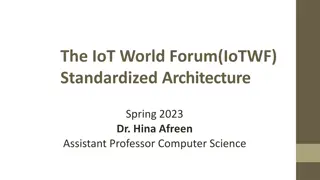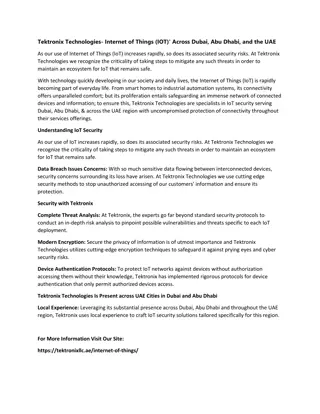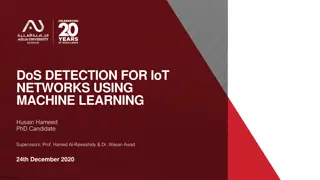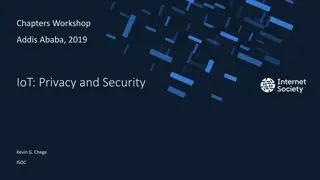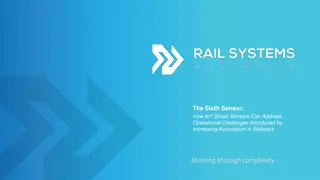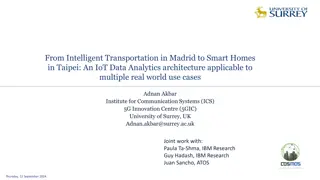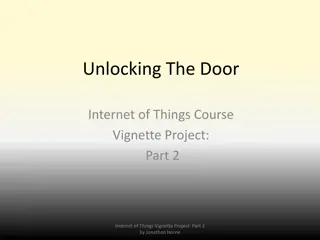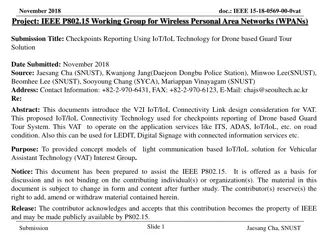
Handling Permanent and Temporary IDs in Ambient IoT Devices
This draft session delves into the key issues of managing permanent and temporary device IDs for Ambient IoT devices. It discusses differentiating between third-party allocated and operator-allocated IDs, the importance of security protections, considerations for non-volatile memory operations, and the impact of business models on device lifecycle management. The session highlights the challenges and risks associated with unclear business models and lifecycle management within the 3GPP scope for Ambient IoT services and devices.
Download Presentation

Please find below an Image/Link to download the presentation.
The content on the website is provided AS IS for your information and personal use only. It may not be sold, licensed, or shared on other websites without obtaining consent from the author. If you encounter any issues during the download, it is possible that the publisher has removed the file from their server.
You are allowed to download the files provided on this website for personal or commercial use, subject to the condition that they are used lawfully. All files are the property of their respective owners.
The content on the website is provided AS IS for your information and personal use only. It may not be sold, licensed, or shared on other websites without obtaining consent from the author.
E N D
Presentation Transcript
S2-24xxxxxx Ambient IoT Drafting Session SA2#165 Huawei, OPPO (Rapporteurs) 1
Key issue 2 Key issue 2 --- --- Permanent Device ID component Permanent Device ID component Baseline paper: S2-2409705 Way forward? Option 1 (figure in 2410411) Option 2 (part 1 + part 2) Part1 information: One bit to differentiate the 3rd party allocated and operator allocated ID. (coding) scheme: in case the identifier is EPC, then the scheme information is the EPC scheme. In case the identifier is allocated by an operator, the scheme can be operator. The operation entity information which can be the company of the EPC the information to identify the corresponding authentication server and the its corresponding location information Part 2 information: the information used to distinguish different Ambient IoT Device within the Part1 information. Details of the component (in S2-2410412) Home Network Identifier: either identify the operator holding the subscription-like information or indicate that no operator is holding the subscription-like information (e.g. by setting to a specific value). Instance Identifier: identify a specific Ambient IoT Device. The Instance Identifier can be GS1 EPC or based on implementation The Home Network Identifier is used to locate the network storing subscription-like information. If the Home Network Identifier indicates that no operator holding the subscription-like information, local configuration can be checked to locate the subscription-like information. 2
Key issue 2 Key issue 2 --- --- temporary ID temporary ID Baseline paper: S2-2410227 (way forward) Principle-level consensus? Justification to support temporary ID (S2-2410448) Justification NOT to support temporary ID (S2-2410448) SA1 TS 22.369 states: Observation 1: The read sensitivity is up to -25.5 dBm with a dipole antenna, while the write sensitivity is up to -20 dBm with a dipole antenna. power consumption of writing operation to non-volatile memory is three times as many as read operation. The 5G system shall enable security protection suitable for Ambient IoT, without compromising overall 5G security protection. Observation 2: SA1 requirement indicates security protection should be maintained for Ambient IoT. Observation 2: if all conditions except communication range remain same for read operation and write operation, shorter communication range is required to ensure reliable write operation compared with read operation. R1-2407364 clarifies it can be assumed an Ambient IoT device comprises a non volatile memory. RAN1 also indicates frequent writing to the NVM may not be preferred. Observation 3: The memory write speed is 3.2 ms per Write, BlockWrite, Lock or Kill operation, for writing up to 32 bits. Writing operation introduces much larger latency compared with reading operation, leading to significantly lower service operation efficiency. Observation 3: RAN1 indicates Ambient IoT devices will have an updatable NVM. Observation 4: RAN1 indicates writing frequency to Ambient IoT s NVM should be limited, hence the frequency of refreshing an Ambient IoT s NVM needs to be considered. SA plenary has sent an LS to SA1 asking for clarifications, as documented in SP-241016. Observation 4: Enlarging non-volatile memory will decrease read / write sensitivity, further leading to increasing power consumption, decreasing throughput and increasing latency. These contentious issues and risks are largely related to unclear business models (e.g. subscription of devices or of application servers, i.e. does each device need to be charged individually, or aggregated charging per application server) and 3GPP scope of lifecycle management (e.g. initial provisioning, transfer of ownership, etc.) for Ambient IoT Services and devices for the SA3 discussion. Observation 5: Tag memory (non-volatile memory) is designed to endure 10,000 write cycles or retain data for 10 years. Hence, the writing operation should be avoided as much as possible to enable a longer life cycle of an Ambient IoT Device. Observation 5: It is currently unclear what is the business model targeted for Ambient IoT devices, hence which entity is responsible for generating/triggering a refresh of the temporary identifier can be determined during normative phase based on SA1 feedback. Observation 8: Additional issues are introduced by a Temporary ID (e.g. synchronization between an Ambient IoT Device and network especially when the Ambient IoT Device moves to a new area) which have not been addressed. 3
Key issue 2 Key issue 2 --- --- temporary ID temporary ID Baseline paper: S2-2410227 Check the proposal if principle(s) can be reached (Proposals to the conclusion) An Ambient IoT device utilizes a temporary identifier to prevent unauthorized tracking of the Ambient IoT device. If the temporary ID allocation is required for the privacy protection, then temporary ID is stored in the non-volatile memory in the Ambient IoT Device. If the Ambient IoT Device receives the temporary ID, the Ambient IoT Device indicates to the AIoT NF whether it can store the temporary ID to the non-volatile memory. Editor's note: The frequency of updating the temporary identifier is FFS. Editor's note: Whether the temporary ID allocation is required for the privacy protection is FFS and is in the remit of SA3. Both permanent device identifier and temporary identifier can be used in RAN procedures, denpending on the security policy of the AIoT service and physical channel capacity. The Reader determines whether to use permanent device identifier or temporary identifier for each AIoT communication. If temporary identifier is to be used, the Reader generates the temporary identifier and uses it in the DL trigger/Paging message. How the temporary identifier is generated and coordinated between the device and reader can be decided during the normative phase. Editor's note: The above conclusion is pending SA3 confirmation. 4
Key issue 1 Key issue 1 --- --- Topology 2 architecture Topology 2 architecture User-plane option S2-2410227 To connect to the AIoT NF, the UE establishes a PDU Session to a specific DNN/S- NSSAI. Editor's note: The DNN/S-NSSAI may be locally configured in the UE, e.g. using existing AT commands. Other options, e.g. based on URSP are FFS. Once the PDU Session has been established, the Reader function in the UE registers with the AIoT NF using the AIoT AP protocol. Editor's note: The UE Reader selects the AIoT NF based on a predefined FQDN. Other options are FFS. If the AIoT NF detects that the Reader function in the UE does not respond to an Inventory Request or Command Request, then the AIoT NF considers the UE Reader unreachable und locally deletes the registration for the UE Reader. If the UE IP address changes, then the Reader function in the UE will re-register with AIoT NF. Reader function in the UE connects to the AIoT NF based on the AIoT Application Protocol (AIoT-AP) using an IP PDU Session between the UE and the UPF as transport. 5
Key issue 1 Key issue 1 --- --- Topology 2 architecture Topology 2 architecture RRC option S2-2410227, 2410110 AIOTF: Distribute AIoT device NAS messages to NG- AIOT device NAS layer: The NAS protocol between AIOTF and AIoT devices. AIOT AS layer: The AS protocol layers between UE reader and AIoT devices, including physical layer, MAC layer, etc. App layer: The application layer protocol between AIoT devices and AF. In NG-RAN, the AIoT service operation information received in NGAP will be mirrored to Uu AS layer. RAN. NG-RAN: Determine Intermediate UEs, allocate radio resources for communication between Intermediate UEs and AIoT devices, forwards device NAS messages to Intermediate UEs, and forwards the response to AIOTF. 6
Key issue 1 Key issue 1 --- --- Topology 2 architecture Topology 2 architecture NAS option, 2409706 7
Key issue 1 Key issue 1 --- --- Topology 2 architecture Topology 2 architecture Who selects UE reader Transmission path between AIoTF and UE reader (UL /DL) (*) (Whether and) how to deliver assistant info of AIOT service request to gNB (for RAN to determine AIOT radio resource) How UE reader requests radio resource UP option AF UP path of PDU session N/A UE requests to gNB RRC option CN? RAN? Both? NGAP (NGAP can be AMF-RAN or AIOTF to RAN) + RRC NG-AP UE requests to gNB NAS option CN AIOTF-AMF-UE reader NG-AP UE requests to gNB Observation (*): for a certain AIOT service operation, the UL and DL transmission can be combination of two of the three options, e.g. DL using NAS, UL using UP Way forward: 1. radio resource allocation: UE requests to gNB ? 2. Anything else? 8
Key issue 1 Key issue 1 --- --- Topology 1 architecture Topology 1 architecture Option 1: direct interface option, BS reader communicates with AIoTF using a direct interface - referenced TR solution: solution 17 Option 2: AMF option, BS reader communicates with AIoTF via AMF - referenced TR solution: solution 5 Way forward: 9

